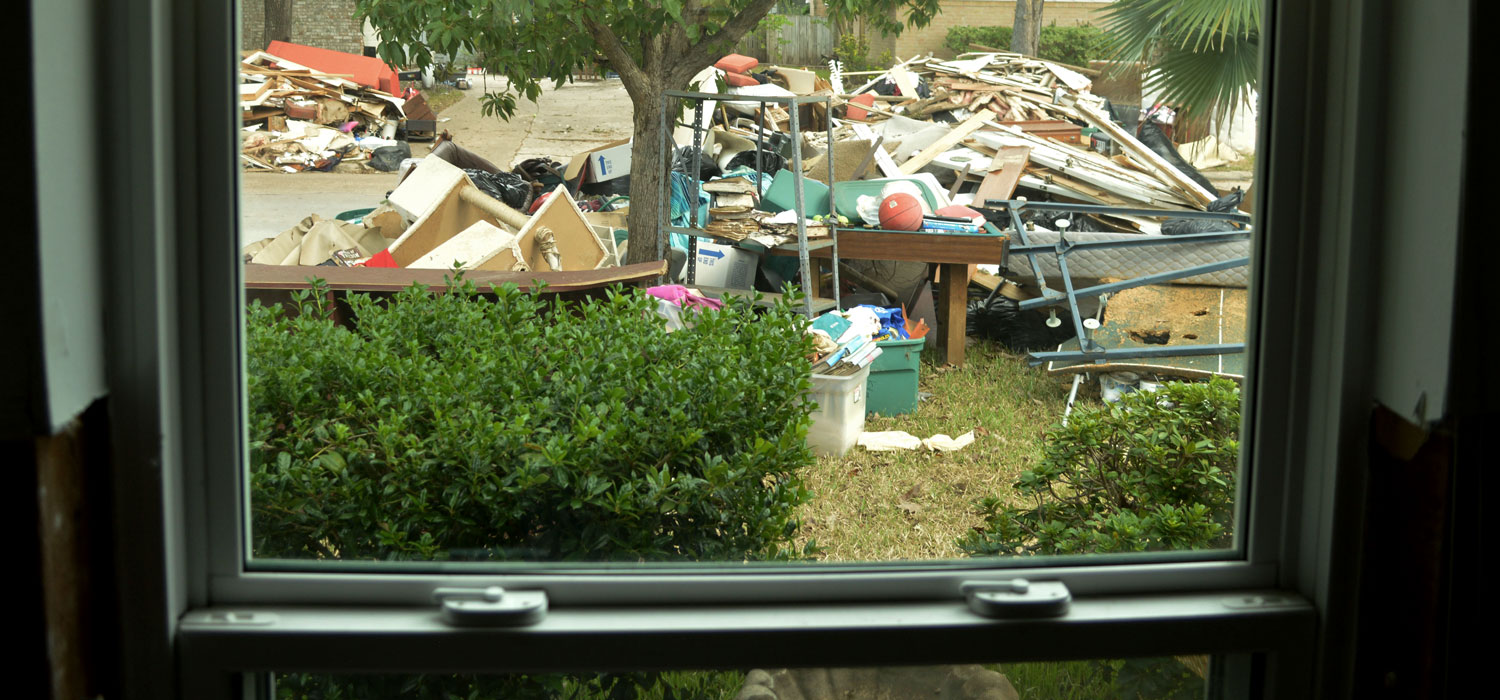
<p>Damaged furniture is seen on the lawn from the window of the home of Christine Contreras Kahan, 61, on Sept. 26, 2017, a month after massive floods struck Houston, Texas. Photo by Russell Contreras/AP.</p>
One year after Hurricane Harvey made landfall in Texas as the first in a series of major disasters, we continue to hear stories about families affected by storms and wildfires that are still living in substandard or temporary housing. In some cases, these people did not have the bandwidth or ability to apply for assistance. But many applied for aid and were denied or are still waiting for assistance.
Improving data collection and data linking between agencies can help ensure recovery aid is equitably distributed to all disaster victims.

Click here to view a larger version of the graphic above
Waiting for assistance after a disaster
Many disaster-affected households rely on private insurance, which leads to other challenges. Many others slip through cracks between private insurance and public assistance and remain in need.
The Federal Emergency Management Agency (FEMA) and the Small Business Administration (SBA) reject far more applications for aid than they accept. Last year, FEMA accepted just over one-third (34.4 percent) of applications for individual assistance in Texas, Florida, Puerto Rico, and California following Hurricanes Harvey, Irma, and Maria and the Northern California wildfires.

The SBA disaster home loan program, designed to support homeowners whose homes suffer physical damage, draws far fewer applications than FEMA Individual Assistance (IA). But the program still only approved 36 percent of applications in the states and territories affected by major disasters last year.

Keeping track of programs
Part of what we know about who gets assistance comes from how federal agencies track their programs. Federal aid application and review data evolve into administrative data used by states to develop action plans for the Department of Housing and Urban Development’s (HUD) Disaster Recovery Grant Reporting (DRGR) program. FEMA’s National Emergency Management Information System and DRGR, along with HUD grantees’ internal reporting systems, help agencies monitor grant expenditures, meet performance targets, and track financial accounts.
These data are used for up to five years after a disaster. Aid agencies are hindered by inconsistent rules and regulations and, too frequently, an inability to link administrative data systems across federal and local agencies and private insurers. Because they exist relatively independent of each other except when engaged in formal data sharing, they can’t produce much beyond synthesis reports to Congress and the public.
Without these data, agencies and communities can’t analyze the original damage assessments and unmet need estimates, and they can’t determine whether the aid they supply ultimately satisfies the original demand.
What’s at risk with incomplete data
These data limitations prevent federal and local agencies from providing integrated case management for disaster-affected households and expediting aid delivery for those with the greatest need. As a result, applicants are forced to continuously apply and document their requests while managing their own relocation and home repair.
And although they are necessary for the financial monitoring of grant operations, administrative datasets and tools created by FEMA, HUD, and the SBA are not useful for collecting data that should be analyzed for compliance with other federal laws and requirements, such as the Fair Housing Act.
For example, FEMA does not collect any demographic information from applicants or recipients on the protected classes of race, ethnicity, nationality, age, or gender. Data on income and household composition are used only to establish aid levels.
Without these data, aggregate information that predates the disaster (often taken from as far back as the last decennial Census) is used to determine how and where aid should be allocated—but not whether that aid was provided in nondiscriminatory or equitable ways.
Filling the data gaps to ensure equitable recovery
Several steps can be taken to improve the disaster safety net’s data to help expedite aid and ensure it is delivered fairly:
- Improve data collection and establish interconnected data systems. FEMA has made improving grants management and data analytics a central component of its 2018-2022 Strategic Plan, and HUD is planning to do the same. But much work remains to be done to establish a comprehensive disaster data management system in the federal government.
- Draw from other social services assistance programs to establish best practices for case management and management information systems. These systems should be user friendly for disaster victims but also provide detailed information so that programs can track and document any assistance.
- Require that every program, including civil-sector charities and private-sector insurers, collect additional demographic data as early as possible and throughout the recovery process. We know little about whether short- and medium-term recovery efforts are equitable, especially among different racial and ethnic groups.
Supplementing data internally within aid programs and providing them in aggregate to communities can help address disparate treatment that has plagued disaster aid since Hurricane Katrina and has persisted in the aftermath of the 2017 disasters. One year after Harvey hit, we still haven’t learned how to make sure that everyone recovers equitably.
Let’s build a future where everyone, everywhere has the opportunity and power to thrive
Urban is more determined than ever to partner with changemakers to unlock opportunities that give people across the country a fair shot at reaching their fullest potential. Invest in Urban to power this type of work.